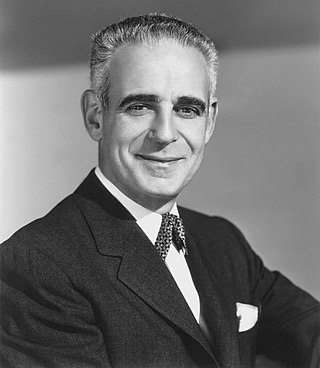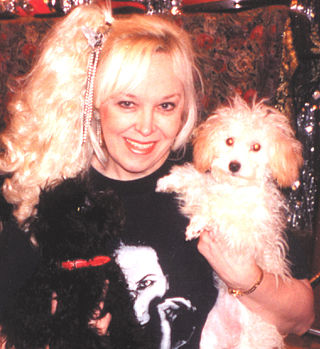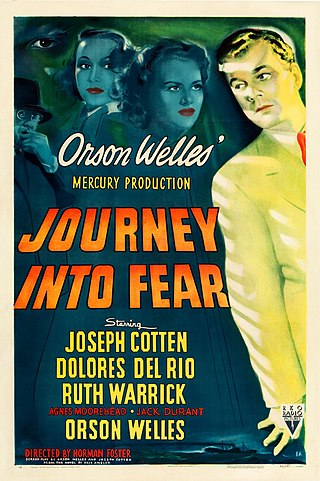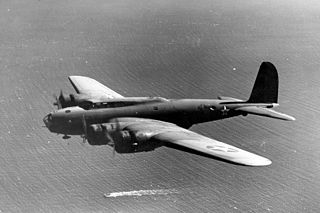
Joseph Cheshire Cotten Jr. was an American film, stage, radio and television actor. Cotten achieved prominence on Broadway, starring in the original stage productions of The Philadelphia Story (1939) and Sabrina Fair (1953). He then gained worldwide fame for his collaborations with Orson Welles on three films, Citizen Kane (1941), The Magnificent Ambersons (1942), and Journey into Fear (1943), which Cotten starred in and for which he was also credited with the screenplay.

George Orson Welles was an American director, actor, writer, producer, and magician who is remembered for his innovative work in film, radio, and theatre. He is considered to be among the greatest and most influential filmmakers of all time.

Erik Weisz, known as Harry Houdini, was a Hungarian-American escape artist, illusionist, and stunt performer, noted for his escape acts.

Douglas James Henning was a Canadian magician, illusionist, escape artist and politician.

Rita Hayworth was an American actress. She achieved fame in the 1940s as one of the top stars of the Golden Age of Hollywood, and appeared in 61 films in total over 37 years. The press coined the term "The Love Goddess" to describe Hayworth after she had become the most glamorous screen idol of the 1940s. She was the top pin-up girl for GIs during World War II.

David Seth Kotkin, known professionally as David Copperfield, is an American magician, described by Forbes as the most commercially successful magician in history.

Paul Stewart was an American character actor, director and producer who worked in theatre, radio, films and television. He frequently portrayed cynical and sinister characters throughout his career.
This timeline of magic is a history of the performing art of illusion from B.C. to the present.

The Magnificent Ambersons is a 1942 American period drama written, produced, and directed by Orson Welles. Welles adapted Booth Tarkington's Pulitzer Prize–winning 1918 novel about the declining fortunes of a wealthy Midwestern family and the social changes brought by the automobile age. The film stars Joseph Cotten, Dolores Costello, Anne Baxter, Tim Holt, Agnes Moorehead and Ray Collins, with Welles providing the narration.

The Other Side of the Wind is a 2018 satirical drama film co-written, co-edited, and directed by Orson Welles, and posthumously released in 2018 after 48 years in development. The film stars John Huston, Bob Random, Peter Bogdanovich, Susan Strasberg, and Oja Kodar.

Dorothy Dietrich is an American stage magician and escapologist, best known for performing the bullet catch in her mouth and the first woman to perform a straitjacket escape while suspended hundreds of feet in the air from a burning rope. She was the first woman to gain prominence as an escape artist since the days of Houdini, breaking the glass ceiling for women in the field of escapes and magic.

Journey into Fear is a 1943 American spy film noir directed by Norman Foster, based on the 1940 Eric Ambler novel of the same name. The film broadly follows the plot of the book, but the protagonist was changed to an American engineer, and the destination of his journey changed from France to the Soviet Union - reflecting the changes in the war situation since the original Ambler book was written. The RKO Pictures release stars Joseph Cotten, who also wrote the screenplay with Orson Welles. The Mercury Production was also produced by Welles, again uncredited.

Orson Welles' Sketch Book is a series of six short television commentaries by Orson Welles for the BBC in 1955. Written and presented by Welles, the 15-minute episodes present the filmmaker's commentaries on a range of subjects. Welles frequently draws from his own experiences and often illustrates the episodes with his own sketches.

The Orson Welles Show (1941–42), also known as The Orson Welles Theater, Orson Welles and his Mercury Theater and the Lady Esther Show, was a live CBS Radio series produced, directed and hosted by Orson Welles. Broadcast Mondays at 10 p.m. ET, it made its debut September 15, 1941. Its last broadcast was February 2, 1942.
George Schindler is an American stage magician, magic consultant, comedian, actor, ventriloquist and writer based in New York. In addition to creating noteworthy illusions and publishing many books on magic, Schindler has performed at venues around the world and is currently "lifetime dean" of the Society of American Magicians, having previous tenure in the "S.A.M. Hall of Fame" as well as president and spokesperson. From the 1950s to the 1960s, he had also been a frequent contributor to Billboard Magazine's comedy, magic and vaudeville columns.

Ceiling Unlimited (1942–1944) is a CBS radio series created by Orson Welles and sponsored by the Lockheed-Vega Corporation. The program was conceived to glorify the aviation industry and dramatize its role in World War II.

This is a comprehensive listing of the radio programs made by Orson Welles. Welles was often uncredited for his work, particularly in the years 1934–1937, and he apparently kept no record of his broadcasts.
Radio is what I love most of all. The wonderful excitement of what could happen in live radio, when everything that could go wrong did go wrong. I was making a couple of thousand a week, scampering in ambulances from studio to studio, and committing much of what I made to support the Mercury. I wouldn't want to return to those frenetic 20-hour working day years, but I miss them because they are so irredeemably gone.
Magic Trick is a short film made in 1953 by Orson Welles, for use in a show by magician Richard Himber. It involves Welles on-screen interacting with Himber off-screen as the two play a card trick, and would have been projected life-size during Himber's touring stage show in the 1950s.

The Orson Welles Almanac is a 1944 CBS Radio series directed and hosted by Orson Welles. Broadcast live on the Columbia Pacific Network, the 30-minute variety program was heard Wednesdays at 9:30 p.m. ET January 26 – July 19, 1944. The series was sponsored by Mobilgas and Mobiloil. Many of the shows originated from U.S. military camps, where Welles and his repertory company and guests entertained the troops with a reduced version of The Mercury Wonder Show. The performances of the all-star jazz band that Welles brought together for the show were an important force in the revival of traditional New Orleans jazz in the 1940s.

This is a comprehensive listing of the theatre work of Orson Welles.
There isn't one person, I suppose, in a million, who knows that I was ever in the theatre.






















